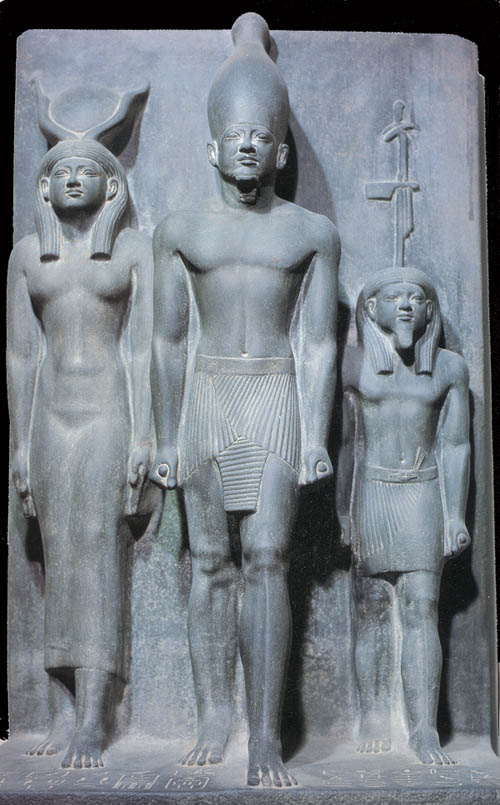
This sculpture shows Pharaoh Menkaure at the centre. (Taken from hethert.org)

This sculpture shows Pharaoh Menkaure at the centre. (Taken from hethert.org)
Menkaure ruled Egypt when Moses led the Israelites out of slavery. Archaeologists have found cattle bone that match the description of the first Passover meal. Pottery left over after the Passover meal have Menkaure’s inscription. Menkaure’s pyramid was unfinished, indicating the workers left without finishing the work. Menkaure was not succeeded by his oldest son. Scripture records that the first son of Pharaoh died prior to the Exodus. There was a funeral procession when a Pharaoh died, where his dead body would be brought by boat to his pyramid. However, around Menkaure's pyramid, no boat pits have been found so far. This might have happened if the Pharaoh drowned and his body went missing. There is evidence of a 7 year famine a few generations before Menkaure. Scripture records that the Israelites went to Egypt because of a 7 year famine. The historian Herodotus wrote that money was scarce after Menkaure's reign. The bible records that the Egyptians gave the Israelites gold and silver as they left Egypt.
On the first Passover, Yahweh commanded Moses, The animals you choose must be year-old males without defect, and you may take them from the sheep or the goats.
(Exodus 12:5).
Richard Redding, an archaeozoologist, has analyzed the animal bone remains at a residential complex near the Giza pyramid. Based on the fusion of the bones, he calculated that more than 84% of the animals at this site were less than 2 years old, and the ratio of males to females was 4:1. (Redding 1992).
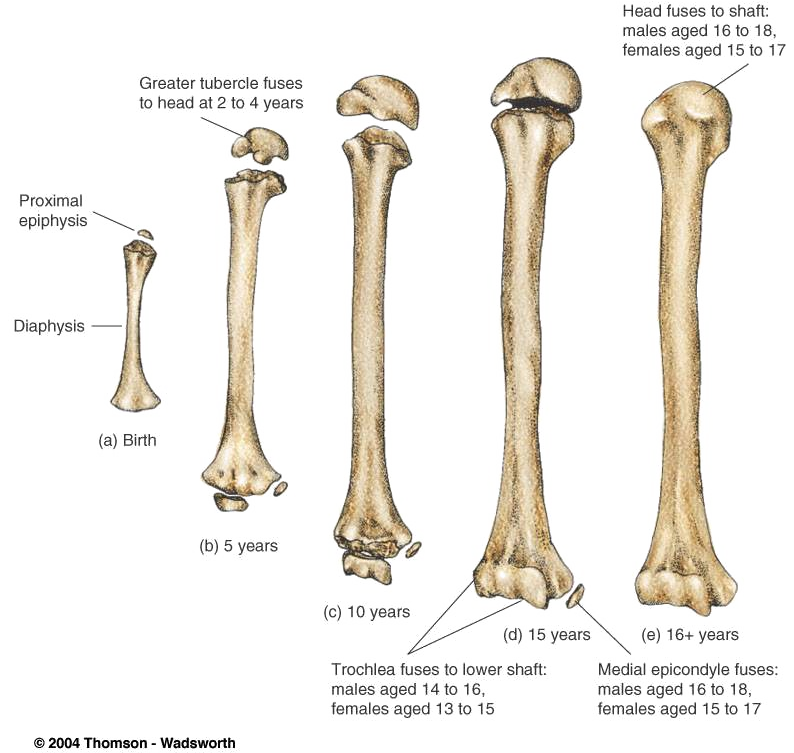
Human bone development illustrates how fusion of the epiphysis to the diaphysis enables archaeologists to predict the age of the animal when it died. (Taken from yorku.ca)
The bones are from a deposit that is filled with seal impressions having the name of Menkaure on them. (Nolan 2010). Not only do the bone deposits have seals with Menkaure's inscription, the 'bakeries' do too.
Mark Lehner wrote, When the ash had filled up the two little open-air bakeries, the bakery workers vacated the premises, leaving behind bread pots lying upon the ashy, black layer.
(Lehner 1998)
The last work at Egypt that Moses commanded them to do was: Do no work at all on these days, except prepare food for everyone to eat; that is all you may do.
(Exodus 12:16). So to the modern archaeologist excavating Giza, it seems like there were bakeries and meat processing factories.
Lehner describes in detail how archaeologists recovered mud sealings from this site, and wrote, Of the 33 impressions which have traces of identifiable royal names, 26 have the name of Menkaure.
Richard Redding compared the diet at Giza to other sites of Egypt and remarked, The differences include the extremely high number of cattle, the very young age of the cattle slaughtered and the occurrence of hind limb fragments almost to the exclusion of fore limb fragments. This is the most unusual aspect of this deposit.
(Appendix 1 of John Nolan's dissertation). Jews did not consume the some meat associated with the hind legs because Jacob was injured at his hip (Genesis 32). This practice somehow caused the hind legs to be preserved in the deposits.
Jesus is the new Passover sacrifice because he frees people from the slavery to sin and debts. The leg bones of the other 2 people crucified with Jesus were broken, but Jesus' were not. Jesus also died during the Passover celebration. (John 19:14,33)
Menkaure's pyramid was built initially using massive blocks of limestone, but finished using crude bricks. (Reisner 1931) This might have happened if the workers who initially built using massive blocks of limestone left the country.
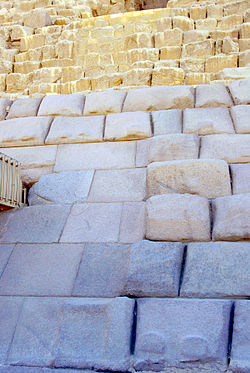
Limestone base of Menkaure's pyramid from Wikipedia
In the book, The pyramids of Egypt, I.E.S. Edwards has described the elaborate funerary ritual that took place when a king died. The king's body would be brought to the Valley Temple from Memphis by boat. (Jenkins 1980). Unlike the great pyramid of Khufu and the pyramid of Khafre no boat pits have been discovered in the pyramid complex of Menkaure despite an intensive search (ancientegyptonline.co.uk).

This boat was found beside Khufu's pyramid. It was restored from 1223 pieces by Ahmed Youssef Moustafa. (Jenkins 1980)
Exodus 14 records that Pharaoh took his entire army with him to pursue the Israelites, but they drowned in the sea. So there was no funeral procession for Menkaure.
Menkaure's oldest son Prince Khuwnera did not succeed his father as king (Reisner 1931). This would have happened if the firstborn of every Egyptian died on the Passover. Shepseskaf succeeded Menkaure and continued working on his father's the unfinished pyramid.
Skulls that have been excavated from Giza have severe gashes and regularly shaped lesions (Filer 1992). An example is shown below:

Zahi Hawass wrote, Simple and multiple limb fractures were found in skeletons from both the lower and upper burials. The most frequent were fractures of the ulna and radius, the bones of the upper arm, and of the fibula, the more delicate of the two lower leg bones.
(Hawass 1997).
Neither Filer nor Hawass attributed these observations to cruel slavery. Filer compared the skulls at Giza with those from Kerma, and wrote, The Kerma group had no severe gashes. In the Giza group the most common type of injury is the severe gash,... it seems likely that the gashes were made by axes or swords smashing down onto the head.
The gashes were not made by 'axes or swords smashing down onto the head' because the skull isn't broken at those locations. The workers had to carry very heavy blocks. The weight was probably supported by their heads, and this continuous practice for many years caused a depression in the skull that looks like a gash. The 'bricks' used to construct the pyramids at Giza weighed several tonnes.
According to biblical chronology, the Exodus happened at 1476BC, but according to modern Egyptian chronology, Menkaure ruled at around 2400BC. How do we resolve this contradiction of 10 centuries?
Djoser ruled during the 7 year famine as recorded in the famine stela (Lichtheim). Based on dendrochronology, tree rings at around 1628 BC have a very small width compared to the earlier years. There were few years where the tree ring widths were about 3 standard deviations less than the average. The few years preceding this era had tree rings about 2 standard deviations more than the average. Grudd et al measured 7 consecutive rings during this period that were smaller than the average, and 6 consecutive rings prior to that which were larger than the average as shown in the following graph:
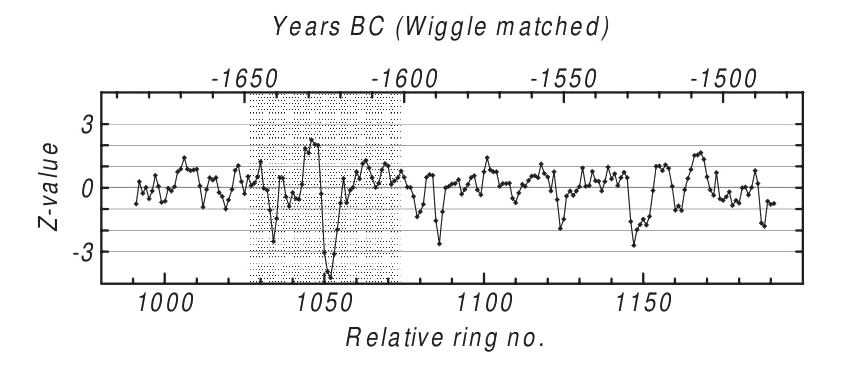
Tree ring data records the years of abundance followed by the years of famine at 1628BC.
According to modern Egyptian chronology, Menkaure ruled 140 years after Djoser. 1628BC + 140 years = 1488BC. This kind of 'relative' calculation relies on less number of assumptions than an absolute chronology spanning over an entire civilization.
Herodotus, a Greek historian who lived in the 5th century BC wrote a lot about Egypt and Menkaure (Mycerinus in Greek). His writings were based on what priests told him. He wrote, Menkaure disapproved the conduct of his father, re-opened the temples, and allowed the people, who were ground down to the lowest point of misery, to return to their occupations, and to resume the practice of sacrifice. His justice in the decision of causes was beyond that of all the former kings. The Egyptians praise him in this respect more highly than any of their other monarchs, declaring that he not only gave his judgments with fairness, but also, when any one was dissatisfied with his sentence, made compensation to him out of his own purse
Menkaure's pyramid is smaller than his predecessors: This may prove that he was more compassionate than his father.

Menkaure's pyramid is at the lower left. The gash on Menkaure's pyramid was made by Al-Aziz Uthman. The pyramids of Menkaure's predecessors are bigger than his. This satellite image is from Google maps.
Exodus 4 records that Yahweh told Moses, When you return to Egypt, see that you perform before Pharaoh all the wonders I have given you the power to do. But I will harden his heart so that he will not let the people go. Then say to Pharaoh, ‘This is what Yahweh says: Israel is my firstborn son, and I told you, “Let my son go, so he may worship me.” But you refused to let him go; so I will kill your firstborn son.
Exodus 5 records that the Israelites appealed to Pharaoh after their workload was increased. If the Pharaoh at the time of the Exodus was very cruel, they would not have hoped that their appeal would be successful. And when their request was denied, they said to Moses and Aaron, May Yahweh look on you and judge you! You have made us obnoxious to Pharaoh and his officials and have put a sword in their hand to kill us.
In other words, the Pharaoh who ruled during the Exodus was not naturally cruel, but was 'hardened'.
Herodotus also writes that there was an oracle against him saying, Six years only shalt thou live upon the earth, and in the seventh thou shalt end thy days.
Menkaure reproached God for his injustice saying, My father and uncle,
he said, though they shut up the temples, took no thought of the gods, and destroyed multitudes of men, nevertheless enjoyed a long life; I, who am pious, am to die so soon!
This prophecy against Menkaure is linked to the 'thick and dreadful darkness' that came upon Abraham as recorded in Genesis 15: Know for certain that for four hundred years your descendants will be strangers in a country not their own and that they will be enslaved and mistreated there. But I will punish the nation they serve as slaves, and afterward they will come out with great possessions.
The prophecy against Menkaure mentions that Egypt was fated to suffer affliction 150 years, and because Menkaure was more compassionate than the 2 kings who preceded him, his life was fated to end quickly.
Herodotus also mentions that after Menkaure, Asychis ascended to the throne, and that money was scarce during his reign. Exodus 12 records that the Israelites were given gold and silver as they left Egypt, so it is not surprising that money was scarce after Menkaure's reign.
Genesis 46 and Exodus 8:22 record the Israelites lived in a region called Goshen. If you look up a modern bible map and compare it to a satellite image from google maps, you will realize that Goshen is green, while Giza is a deserted region. How to resolve this contradiction?
Archaeologists have not recovered sheep bone that match the Passover description from Goshen, but from Giza. Joseph's brothers told Pharaoh that they were shepherds, so were allowed to settle in the region of Goshen.

Satellite image of the Nile Delta, from Google Maps
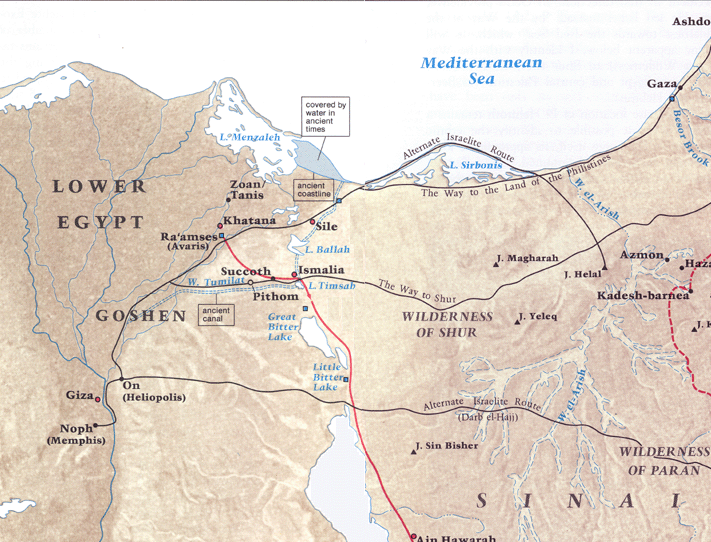
Modern bible map showing Goshen and Giza as separate locations. Taken from bibleistrue.com
Herodotus wrote, For the Ionians say that nothing is really Egypt but the Delta, which extends along shore ... But the Delta, as the Egyptians affirm, and as I myself am persuaded, is formed of the deposits of the river, ... ".
During Joseph's time Giza may have been green but slowly became a desert and the fertile area (called Goshen) gradually moved north as the Nile deposits created more land. Bible scholars would associate Goshen with a green fertile land, and may not have realized that Giza could have been fertile once upon a time.
Giza and Goshen start with the letter 'g', and the second syllable has the 's' sound. Shepherds would not have chosen a desert to settle in. Giza and Goshen could have been the same.
Another confusing verse is Exodus 1:11; "So they put slave masters over them to oppress them with forced labor, and they built Pithom and Rameses as store cities for Pharaoh." Mention of Pithom and Rameses is absent in the Dead Sea Scrolls, which is the oldest old testament manuscript we have, but only present in later manuscripts (Griffin). When the later manuscripts were produced, the scribes may not have known what the slaves built, and may have resorted to guesswork. Cities to the north of Giza would have been created by deposits from the Nile after Giza was created. Rameses reigned long after Menkaure died. A city named after Rameses would have come into existence much later than Giza.
The lower fragment of image 'B-482987' of the digitized Dead Sea Scrolls library has a reference to this ambiguity. It seems to me that somewhere
along the line, a scribe mistook the 'D' as an 'S' and the ancient Hebrew word for pyramid became 'Pithom and Rameses'. The Egyptians practised the
doubling of a sign to indicate its dual and the tripling of a sign to indicate its plural, so the letter 'D' is repeated as seen below to denote
multiple pyramids. The Hebrews may have adopted this practice when the book of Exodus was first written, and then long forgotten. This identification
of letters has been done by comparing the image to an ancient Hebrew letter chart:
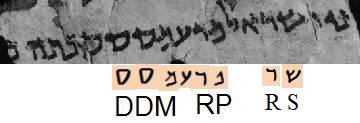
The historian Josephus, who lived after the siege of Jerusalem probably knew where these scriptures were hidden, and wrote that the Jews built the pyramids (Antiquities 2:9:1). In the preface of the Antiquities, he admitted that his writing to the Greeks were based on his reading of the Hebrew scriptures. If Pithom and Rameses were cities that the Jews built, why didn't Josephus say so?
It is easier to deny the existence of the mid-day sun at noon,
and convince men that they came from the hairy babboon,
while hoping steadfastly that truth will not reveal itself soon,
than denying Menkaure ruled during the first Passover full moon.
© Selva Harris
2016